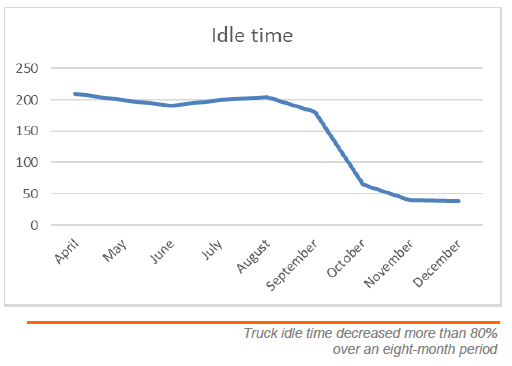DISPATCH Fleet Management system (FMS) helps mine optimize its haulage cycle and dramatically reduce truck idle times
Challenge
Frequent changes in crusher status (Ready vs. Down) and a lack of communication between the crusher operator and the central dispatcher, led to haul trucks arriving at, and queuing for, the crusher when it was non-operational. The mine sought to improve the status notification process which would, in turn, enable haul trucks to be efficiently rerouted to an alternate dumping location, thus reducing excessive idle time.
LOCATION
Arkhangelskgeolbycha (AGD) Grib Diamond Mine
Arkhangelsk, Russia
OBJECTIVE
Prevent haul trucks from being assigned to crusher when crusher is Down
OUTCOME
Improved communications leading to reduced crusher queues, improved fuel burn rates, and increased truck and shovel utilization

Background
Before Modular’s involvement, the mine relied on a traffic signal on the road leading to the crusher to alert haul truck drivers of crusher status. A green light indicated Ready (operational); a red light indicated Down (non-operational).
Frequent changes in crusher status and the lack of automated communications between the crusher operator and the central dispatcher meant trucks were often assigned to the crusher despite it being in a Down state.
This resulted in one or more trucks regularly left queuing at the traffic light while waiting for the crusher to resume operation, which lowered equipment utilization and affected the fuel burn calculations.
Methodology
Modular implemented the DISPATCH FMS at Grib mine in 2015, thus enabling the mine to maximize the load of its excavator fleet and improve overall equipment utilization. In addition, a computer was installed to facilitate communication between the crusher operator and the central dispatcher. This enabled the crusher operator to use the DISPATCH system to
quickly and easily notify the central dispatcher of real-time changes in crusher status.
In response to receiving crusher status information, the central dispatcher was then able to use the FMS to immediately change the truck operators’ assignments and avoid sending trucks to the crusher when it was out of service.
Solution
At Modular’s suggestion, the mine implemented a simple, yet effective method for the crusher operator to notify the dispatcher as crusher status changed. The dispatcher was then able to leverage the optimization capabilities of the DISPATCH FMS to change the destination assignments of loaded haul trucks.

Results
The DISPATCH FMS’ proprietary optimization algorithm, as well as the improved communication between the crusher operator and the central dispatcher, helped the mine prevent unnecessary truck queues at the crusher. Truck idle times dropped from 210 hours per month to 38 hours per month, as shown.
Conclusion
Working together, Modular and AGD successfully increased the value that the DISPATCH system brought to the mine’s operations. Because the FMS’ optimization capabilities enabled AGD to automate operator assignments, they were able to alleviate the problem of trucks sitting idle in the crusher queue. Instead, the FMS automatically reassigned the trucks to more efficient activities such as hauling waste or sending trucks to parkup. As a result, the mine realized reduced idle time and increased fleet utilization.

